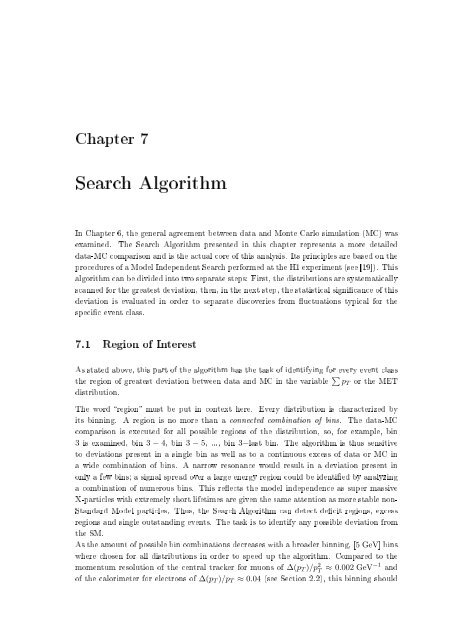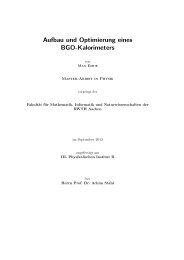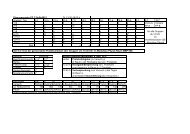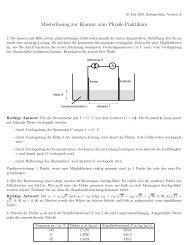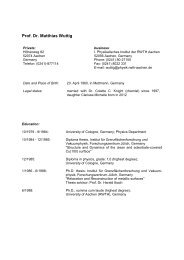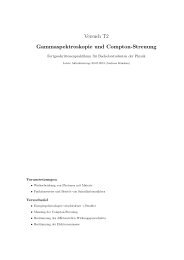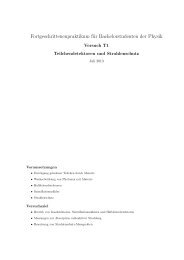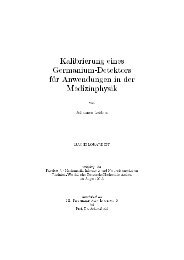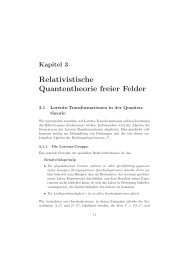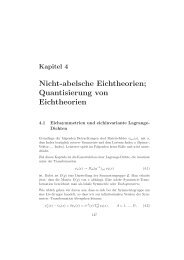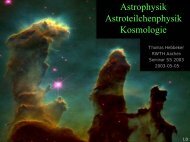Model Independent Search for Deviations from the Standard Model ...
Model Independent Search for Deviations from the Standard Model ...
Model Independent Search for Deviations from the Standard Model ...
You also want an ePaper? Increase the reach of your titles
YUMPU automatically turns print PDFs into web optimized ePapers that Google loves.
Chapter 7<br />
<strong>Search</strong> Algorithm<br />
In Chapter 6, <strong>the</strong> general agreement between data and Monte Carlo simulation (MC) was<br />
examined. The <strong>Search</strong> Algorithm presented in this chapter represents a more detailed<br />
data-MC comparison and is <strong>the</strong> actual core of this analysis. Its principles are based on <strong>the</strong><br />
proceduresofa<strong>Model</strong><strong>Independent</strong><strong>Search</strong>per<strong>for</strong>medat<strong>the</strong>H1experiment(see[19]). This<br />
algorithmcanbedividedintotwoseparatesteps: First,<strong>the</strong>distributionsaresystematically<br />
scanned <strong>for</strong> <strong>the</strong> greatest deviation, <strong>the</strong>n, in <strong>the</strong> next step, <strong>the</strong> statistical signicance of this<br />
deviation is evaluated in order to separate discoveries <strong>from</strong> uctuations typical <strong>for</strong> <strong>the</strong><br />
specic event class.<br />
7.1 Region of Interest<br />
As stated above, this part of <strong>the</strong> algorithm has <strong>the</strong> task of identifying <strong>for</strong> every event class<br />
<strong>the</strong> region of greatest deviation between data and MC in <strong>the</strong> variable ∑ p T or <strong>the</strong> MET<br />
distribution.<br />
The word region must be put in context here. Every distribution is characterized by<br />
its binning. A region is no more than a connected combination of bins. The data-MC<br />
comparison is executed <strong>for</strong> all possible regions of <strong>the</strong> distribution, so, <strong>for</strong> example, bin<br />
3 is examined, bin 3 − 4, bin 3 − 5, ..., bin 3−last bin. The algorithm is thus sensitive<br />
to deviations present in a single bin as well as to a continuous excess of data or MC in<br />
a wide combination of bins. A narrow resonance would result in a deviation present in<br />
only a few bins; a signal spread over a large energy region could be identied by analyzing<br />
a combination of numerous bins. This reects <strong>the</strong> model independence as super massive<br />
X-particles with extremely short lifetimes are given <strong>the</strong> same attention as more stable non-<br />
<strong>Standard</strong> <strong>Model</strong> particles. Thus, <strong>the</strong> <strong>Search</strong> Algorithm can detect decit regions, excess<br />
regions and single outstanding events. The task is to identify any possible deviation <strong>from</strong><br />
<strong>the</strong> SM.<br />
As<strong>the</strong>amountofpossiblebincombinationsdecreaseswithabroaderbinning, [5 GeV]bins<br />
where chosen <strong>for</strong> all distributions in order to speed up <strong>the</strong> algorithm. Compared to <strong>the</strong><br />
momentum resolution of <strong>the</strong> central tracker <strong>for</strong> muons of ∆(p T )/p 2 T<br />
and<br />
of <strong>the</strong> calorimeter <strong>for</strong> electrons of ≈ 0.002 GeV−1 ∆(p T )/p T ≈ 0.04 (see Section 2.2), this binning should


